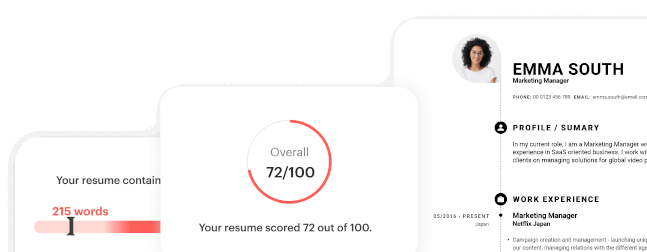Creating a compelling marketing & PR resume is the first call in the journey towards your dream job in this dynamic sector. Your resume needs to shout out your proficiency in creating brand narratives, strategizing marketing initiatives, and your knack for public relations.
With our well-rounded tips, real-world examples, and customizable templates, we're here to help you create a resume that's as engaging as a viral marketing campaign. Ready to promote yourself to the top?
Keep reading and learn how to:
- Craft an eye-catching marketing & PR resume summary
- Showcase your best marketing and PR achievements in a resume
- Effectively present your marketing and PR skills
- Make your marketing & PR resume stand out with relevant extra sections
- Make your PR and marketing resume format shine
- Access valuable job search resources for marketing and PR professionals
Still looking for a job? These 100+ resources will tell you everything you need to get hired fast.
1. How to craft an eye-catching marketing & PR resume summary
Good marketing is about effectively communicating the benefits of a product or service, and how it enhances the customer’s life. When it comes to marketers, your resume should do the same.
A well-crafted resume summary highlights your key skills, industry experience, and notable achievements, instantly conveying your ability to drive successful PR and marketing campaigns.
By emphasizing your strengths and accomplishments upfront, you captivate employers and make a strong impression. The resume summary also enables recruiters to quickly assess your fit for their organization and the specific role they are seeking to fill.
Your resume should start with a great summary that clearly communicates what value you bring to an employer.
Here is a great example of a PR resume summary
Results-driven PR and Marketing professional with 5+ years of experience in developing and executing strategic communications campaigns for diverse industries. Proven track record of driving brand awareness, enhancing reputation, and increasing customer engagement. Skilled in crafting compelling content, managing media relations, and leveraging digital platforms for effective brand positioning. Adept at analyzing market trends, conducting market research, and implementing targeted marketing strategies.
2. How to showcase your best marketing and PR achievements in a resume
Marketing is results-driven. When putting together a list of work experience, it should be about more than just your day-to-day tasks. It’s important to highlight your accomplishments and the specific results that you’ve achieved along the way.
The results you should share depend on the role you’re searching for. For example, if you’re a social media manager, your results might focus on social media engagement. If you’re a paid acquisition specialist, your results might focus on direct conversions from ads.
Make sure to call out any specific results or achievements that you have.
Here are great examples of results and achievements in a marketing resume
- Launched a new social media strategy, increasing social media engagement by 50% over six months.”
- Led an advertising campaign for a new product launch, exceeding initially forecasted revenue by 30%.
- Coordinated a customer research project to improve our marketing strategies based on brand and category awareness.
- Participated in strategic planning for PR channels, including outreach and crisis management strategies.
If your role was more project-based, it’s also helpful to call out any projects you managed and executed.
By focusing on results, you’ll demonstrate your impact and the potential that you can bring to a new team.
3. How to effectively present your marketing & PR skills in a resume
Every resume needs a skills section, especially when you’re on the hunt for roles that require specific skill sets – like marketing! When writing your marketing resume, you should be highlighting your professional marketing skills as well as soft skills.
Including professional skills on your resume helps the hiring manager get a better sense of your fit for a role. For example, a content marketing specialist role likely requires someone with skills in writing and SEO.
Many applicant tracking systems (ATS) also are set up to filter resumes with specific skills listed. If you miss these, there’s a good chance a human recruiter will never even get the chance to read the rest of your resume.
Soft skills are equally as important as professional skills when it comes to marketing. The consistent changes in the marketing landscape mean that employers are often looking for those who are the right fit for the role long-term. For example, a marketing manager role likely requires someone who has strong leadership and interpersonal skills.
When it comes to competencies, carefully read the job posting for keywords. This can give you a better sense of the skills that the employer is looking for, for this role.
Employers are also often looking for candidates that are easy to onboard, without needing extensive training. Making it clear that you’re familiar with tools that are used on prospective teams can help you stand out from other applicants.
Here are some key marketing hard skills to include in your resume
- CMS platforms (ie. WordPress, Squarespace,
- Email marketing software (ie. Salesforce, Hubspot, Mailchimp)
- Data analytics tools (ie. Google Analytics,
- Social media (ie. Instagram, Twitter, TikTok)
- Project management tools (ie. Jira, Asana)
While it can be tempting to add a bunch of software skills to your resume, make sure to only highlight the ones that are relevant to the role and that you’re actually familiar with.
4. Make your marketing & PR resume stand out with relevant extra sections
Including relevant extra sections in your PR and marketing resume is of utmost importance as they provide valuable insights into your qualifications, achievements, and potential contributions beyond the standard sections.
These sections allow you to showcase additional skills, experiences, and accomplishments that are directly relevant to the position you are applying for. By including specific examples, you provide concrete evidence of your expertise and demonstrate your fit for the role.
For instance, if you're applying for a project management position, including an Projects and Achievements section where you list successful projects you have led, their outcomes, and the skills you utilized, highlights your ability to deliver results and effectively manage complex initiatives.
Here's an example of how to successfully list your extra sections in a PR and marketing resume
Projects and Achievements
- Led a cross-functional team in implementing a company-wide CRM system, resulting in a 20% increase in sales productivity and improved customer satisfaction.
- Managed a complex construction project, delivering it within budget and ahead of schedule, while maintaining strict quality standards.
- Streamlined procurement processes, reducing costs by 15% and improving supplier relationships.
Certifications and Training
- Project Management Professional (PMP), Project Management Institute (PMI), 2019
- Agile Certified Practitioner (PMI-ACP), Project Management Institute (PMI), 2020
5. Make your PR & marketing resume format shine
Marketing roles often require a certain level of creativity. Since design and having a creative eye are desired skills in the marketing industry, adding a little flair to your resume can help you stand out in a competitive job market.
This doesn’t mean you need to go crazy either. Unless the role you’re applying for is heavily design-focused, you don’t need to spend hours redesigning your resume. Adding a simple color palette or a few icons can help your resume stand out visually.
We all know recruiters don’t have a lot of time to review each resume in detail. A nice-looking resume is always a plus, but your goal should still be to make your resume as easy to digest as possible. In many situations, basic reformatting and design elements can actually make your resume easier to read.
If you’re not sure where to start, these recruiter-approved templates can help elevate your next resume.
6. Valuable job search resources for marketing and PR professionals
As a professional in the exciting field of marketing & PR, having the right resources at your disposal can elevate your job hunt. Here are some top-tier resources to aid in your search:
- Industry job boards: Websites like MarketingJobs, PRSA Jobcenter, and Mediabistro list several opportunities in the marketing and PR spectrum.
- LinkedIn: Besides job postings, LinkedIn can be your platform for networking with professionals in your field, sharing industry insights, and getting noticed by recruiters.
- Marketing and PR associations: Join professional groups such as the American Marketing Association or Public Relations Society of America. They offer member benefits like networking events, professional development resources, and job listings.
- Recruitment agencies: Consider registering with agencies like Aquent and The Creative Group that focus on matching candidates with roles in the marketing and PR space.
- Online learning platforms: Websites like Coursera and Udemy offer courses to keep your marketing and PR skills sharp and up-to-date.
Harnessing the power of these resources can supercharge your job search and put you on track towards finding your ideal role.
Marketing / PR Resume FAQ
Your resume should clearly highlight your contact information, a career summary or objective, your key skills, work experience, and education. If relevant, you can also include sections for certifications, languages, or major projects.
Start by carefully reading the job posting. Highlight the keywords, and make sure they feature in your resume. Tailor your achievements and experience to show how you meet each requirement.
Most resumes either use a chronological (showcasing your employment history), functional (emphasizing skills over timeline), or hybrid format. As marketing & PR roles are results-driven, a chronological or hybrid format is usually most effective.
Showcasing quantifiable results, such as growth percentages or increased engagement, can make your resume stand out. Additionally, highlighting any unique skills or experiences, like proficiency in digital marketing tools or experience with crisis communication, can set you apart.
It's generally accepted to leave references off your resume unless the job application explicitly asks for them. If an employer wants references, they will ask.

![Representante de ventas en Adidas currículum ejemplo [ES]](https://d1xn1bcogdo8ve.cloudfront.net/472/thumbnail.png)















































![How to Write a Professional Resume Summary? [+Examples]](https://d2xe0iugdha6pz.cloudfront.net/article-small-images/i-Profile.svg)
![How to Put Your Education on a Resume? [+Examples]](https://d2xe0iugdha6pz.cloudfront.net/article-small-images/i-Collage-Universities.svg)
![How to Describe Your Work Experience on a Resume? [+Examples]](https://d2xe0iugdha6pz.cloudfront.net/article-small-images/Experience.svg)


